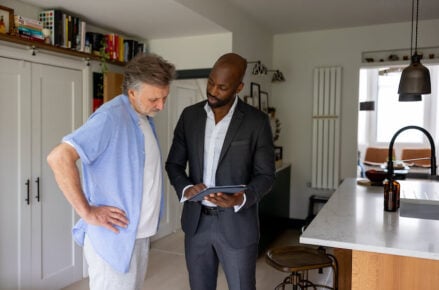A shared ownership mortgage may be able to help you on to the property ladder if your finances mean you’re unlikely to secure a mortgage for the full market value of a home. By allowing you to buy a proportion of a property rather than it all, a shared ownership mortgage – which might also sometimes be referred to as a part ownership mortgage – typically requires a smaller deposit than a traditional mortgage and may be more affordable if you have a lower income. That said, alongside your mortgage payments, rent will be payable on the share of the property that you’re not buying, and other costs may be involved too.
If you have the funds, there’s the option to ‘staircase’ with shared ownership and gradually increase the share of the property you own. Your intentions here can influence how you approach stamp duty – if it is payable – too.
The main focus of this article is how shared ownership mortgages work in England. While schemes with broad similarities are available in the rest of the UK, there are some differences in how they operate. If you want to buy outside of England, further details can be found here:
- Scotland and Shared Ownership
- Wales and Shared Ownership
- Northern Ireland and Co-Ownership
How shared ownership mortgages work
Until April 2021, a shared ownership mortgage could be used to purchase an initial share of between 25% and 75% of a home; now it is possible to take an opening stake of just 10%.
Whatever your starting point, you have the right to increase the share you hold if you’re in a position to do so in the future – this is known as staircasing. You can increase your share by as little as 1% at a time, but there may be a limit on the number of times you’re allowed to staircase, depending on where you live. There’s no obligation to increase your stake if you don’t want to.
Do you pay rent and mortgage on shared ownership?
As well as paying your shared ownership mortgage, you’ll need to pay rent to the housing association, local authority or developer that owns the share of the property that you don’t. Typically, rent will be charged at around 3% on the share that you haven’t bought. So if you have a 50% share in a £200,000 home, rent at 3% on the remaining £100,000 will equate to £3,000 for a year, or £250 per calendar month.
Increase your stake in the property, and these rental costs should fall. It’s possible to staircase until you own a 100% stake in a property, at which point rent will no longer be payable. However, as all shared ownership homes are sold on a leasehold basis, you may still need to pay a service charge to cover the maintenance of communal areas, such as shared stairways and gardens, and ground rent to whoever owns the freehold to the property. These fees should always be considered alongside the mortgage and rental payments when you’re trying to work out if shared ownership is a financially realistic option for you.
Do you pay tax on shared ownership?
You might have to pay Stamp Duty Land Tax if you buy a home using a shared ownership scheme, but there are also times when you might not. If you do need to pay, there are two options:
- A single one-off payment covering the entire value of the home: It may be worth considering this option even if you’re only buying a share of a property, as if you intend to staircase and increase your share beyond 80%, you won’t need to pay any more stamp duty going forward.
- Paying in stages, so you only cover the share that you buy: You can keep initial stamp duty costs to a minimum by only paying on the share that you’re buying. However, increase your share so that you own 80% or more, and stamp duty will be payable on the transaction that saw you pass this threshold, and any other further increments you make. If you don’t intend to ever take a share beyond 80%, this is likely to be the best choice for you; if there’s a chance you might, this may still be worth considering, but there’s the chance that property prices – and therefore the amount of stamp duty you pay – will rise in the meantime.
When you might pay no stamp duty
If you’re taking your first ever step on to the property ladder, and qualify for first-time buyer stamp duty relief, you’ll pay no stamp duty if you’re buying a property – or a share of a property – that is worth £425,000 or less. A 5% charge is payable between £425,001 and £625,000, and there is no relief at all, and normal stamp duty rates apply, above £625,000.
If you’re not a first-time buyer, you must pay in line with the normal stamp duty rates. This means no stamp duty will be charged on a property – or a share of a property – valued at less than £250,000. Beyond that, a rate of 5% is payable between £250,001 and £925,000, and 10% between £925,001 and £1.5 million.
Tenant eligibility requirements for shared ownership
To be eligible for shared ownership in England, you must:
- Have a household income of under £80,000, or £90,000 if you live in London.
- Be a first-time buyer, a previous homeowner who can’t afford to buy now, or already in shared ownership but want to move.
Generally, you will also need a good credit standing, can show you’re able to afford the arrangement you’re hoping to enter into, and won’t be behind on your current mortgage or rent. However, be aware that slightly different eligibility criteria can apply depending on where you’re buying.
How to apply for a shared ownership scheme
To get started, you’ll need to search for shared ownership homes in your area. There are different sites that can set you on the right path, depending on whether you live in London or elsewhere in England.
Housing associations and homebuilders usually advertise the shared ownership homes they have for sale on their websites or at the property developments themselves. Shared ownership properties can also usually be found on local council websites and in general property listings.
Once you’ve found an organisation that is selling shared ownership properties in your area, they will offer support in checking whether shared ownership is affordable for you, and give you a better idea of the type of property – and the share – which your finances will allow. Be prepared to answer questions about your financial situation, including your income, savings, outgoings and any debt you may have.
How to get a shared ownership mortgage
Pass the checks required to qualify for shared ownership, and you can start thinking about getting a shared ownership mortgage. The financial adviser that the Help to Buy agent uses to assess your finances may be able to help you search for a shared ownership mortgage, or you can arrange mortgage advice for yourself.
Applying for a shared ownership mortgage is essentially the same as making any mortgage application. This means a mortgage lender will examine all of the information that you’ve just used to prove your eligibility for shared ownership, including your earnings, savings, debts and credit history. However, when calculating your monthly expenditure, it will also take into account how much you’re likely to pay in rent, maintenance charges and ground rent if they apply.
The size of the shared ownership mortgage you need to borrow will be determined by the share you’re buying and the size of your deposit. So if you want to buy a 50% share in a £200,000 home, and have a £10,000 deposit, you’ll need a mortgage for £90,000 (50% of £200,000, minus £10,000).
How much deposit is needed for shared ownership?
You’ll usually need at least a 5% deposit – calculated on the value of the share that you’re buying – if you want to get a shared ownership mortgage.
A shared ownership calculator can help you work out how much deposit you will need for a share of a house, and whether you might be able to afford shared ownership.
Shared ownership mortgage rates
Typically, shared ownership mortgage rates will be higher than on an equivalent standard residential mortgage, due to a general perception among lenders that they are taking on additional risk. Not all of the major mortgage lenders offer shared ownership mortgages either, so the need for lenders to compete on rate isn’t necessarily as important as it is when it comes to first-time buyer mortgages, for instance.
For this reason, taking the time to weigh up the options and finding the best shared ownership mortgage for you is key.
Can I sell a shared ownership property?
If you want to sell a shared ownership property, and haven’t staircased up to owning your home outright, you must inform the housing association, which owns the remaining share, of your desire to sell. Generally, they will be entitled to attempt to sell the home before you do, and have between four and eight weeks to do so; however, if it’s unsuccessful, then you can take control of the selling process.
Depending on an association’s particular rules, there may still be restrictions on who you can sell to – for instance, the property may need to pass to another shared ownership buyer – so it’s always best to check.
And even if you do own your property outright, it may still be best to talk to the housing association you originally bought your home from, just for peace of mind, before you put it on the market.
Pros and cons of a shared ownership mortgage
A shared ownership mortgage can help make unlikely home buying aspirations come true but it won’t be suitable for all, as these advantages and disadvantages show:
Pros of a shared ownership mortgage
- You may have the chance to get on the property ladder when you thought there was no hope at all.
- You may be able to buy a home much quicker than if you had to save up to buy outright.
- There is the opportunity to gradually increase the share of your home that you own.
- If you decide to sell, you could make a profit if house prices have increased since you bought.
- If you’re military personnel, you get priority over other groups for shared ownership schemes.
Cons of a shared ownership mortgage
- Where you end up living may be dictated by where shared ownership properties are available.
- Increasing your ownership by staircasing could get progressively more expensive if your property value rises.
- Shared ownership mortgage rates are typically higher than on traditional mortgages.
- You’ll pay rent on top of your mortgage payments, unless you staircase to 100% ownership.
- Your property will be on a leasehold, which means paying service charges and ground rent.
- Except for repairs to communal areas and snagging, repair costs above an annual £500 allowance (which is available for the first 10 years after buying) will usually fall on you, regardless of the share you own in the home. (If you bought before April 2021, the allowance isn’t available either.)
- Selling up isn’t always straightforward, particularly if you don’t have 100% ownership.
Alternatives to a shared ownership mortgage
If a shared ownership mortgage isn’t the right option for you, one of these alternatives could help:
Right to Buy mortgages
If you rent from a council or housing association, Right to Buy mortgages can help you buy the home where you live for a reduced price. To be eligible, you’ll have rented the property for three years and it will be your main residence.
First Homes scheme
Introduced in July 2021, the First Homes scheme could allow first-time buyers with less than £80,000 in household income (£90,000 in Greater London) to secure at least a 30% discount when buying a new home.
» MORE: Learn about First Homes
Lifetime ISAs
If saving for a deposit is slow going, a Lifetime ISA boosts your contributions by 25%. These government-backed accounts are tax-free, can be opened if you’re between 18 and 40, and allow £4,000 to be deposited annually up until the age of 50. You will be charged 25% should you withdraw the money before reaching the age of 60 if it isn’t for the purposes of buying your first home. This charge will also not apply if you are terminally ill.
100% mortgages
Also known as guarantor mortgages, with a 100% mortgage the backing of a relative or close friend could mean you are able to secure a mortgage without the need for any deposit at all. However, the credit record of your guarantor is likely to be just as important as yours.
Gifted deposit mortgage
A gifted deposit mortgage sees your loved ones help you out with a mortgage deposit. For it to work, a mortgage lender will want to know that there is no obligation to pay back the money you’ve been given.
Renting
If you’re not in a position to buy, or don’t want to because you may soon want to move, you could consider renting instead. Finances can be important when working out whether it’s best to rent or buy, but your personal preferences and circumstances should be considered too.
Image source: Getty Images

What Happens if my Landlord Sells up?
More and more landlords are throwing in the towel and selling up. But what does it mean for the tenants caught in the middle as the rental market becomes more difficult – and unaffordable – to navigate?

Mortgage Rates Fall as Lenders Look to Compete
Fixed-rate mortgages have been falling as inflation continues its descent and competition among lenders ramps up. Base rate predictions are lowered too. Here are our latest mortgage rate predictions.

6 Tips for Buying a House With a Friend
The housing crisis is making it harder for buyers to afford a home on their own, and some are turning to buying with a friend as a solution. However, this arrangement has financial and legal implications both buyers should understand.

